The Impact of Rayleigh Scattering in UWFBG Array-Based Φ-OTDR and Its Suppression Method
Abstract
1. Introduction
2. Principle
3. Results
3.1. Experimental Setup
3.2. Experimental Results and Discussion
4. Conclusions
Author Contributions
Funding
Institutional Review Board Statement
Informed Consent Statement
Data Availability Statement
Conflicts of Interest
References
- Tu, G.; Zhang, X.; Zhang, Y.; Zhu, F.; Xia, L.; Nakarmi, B. The Development of an Φ-OTDR System for Quantitative Vibration Measurement. IEEE Photonics Technol. Lett. 2015, 27, 1349–1352. [Google Scholar] [CrossRef]
- Redding, B.; Murray, M.J.; Davis, A.; Kirkendall, C. Quantitative amplitude measuring φ-OTDR using multiple uncorrelated Rayleigh backscattering realizations. Opt. Express 2019, 27, 34952–34960. [Google Scholar] [CrossRef] [PubMed]
- Wang, Z.; Jiang, J.; Wang, Z.; Xiong, J.; Rao, Y.J. Bandwidth-enhanced quasi-distributed acoustic sensing with interleaved chirped pulses. IEEE Sens. J. 2020, 20, 12739–12743. [Google Scholar] [CrossRef]
- Li, S.; Qin, Z.; Liu, Z.; Yang, W.; Qu, S.; Wang, Z.; Xu, Y. Long-distance Φ-OTDR with a flexible frequency response based on time division multiplexing. Opt. Express 2021, 29, 32833–32841. [Google Scholar] [CrossRef] [PubMed]
- Peng, F.; Wu, H.; Jia, X.H.; Rao, Y.J.; Wang, Z.N.; Peng, Z.P. Ultra-long high-sensitivity Φ-OTDR for high spatial resolution intrusion detection of pipelines. Opt. Express 2014, 22, 13804–13810. [Google Scholar] [CrossRef]
- Xiong, J.; Wang, Z.; Jiang, J.; Han, B.; Rao, Y. High sensitivity and large measurable range distributed acoustic sensing with Rayleigh-enhanced fiber. Opt. Lett. 2021, 46, 2569–2572. [Google Scholar] [CrossRef]
- Puzrin, A.M.; Iten, M.; Fischli, F. Monitoring of ground displacements using borehole-embedded distributed fibre optic sensors. Q. J. Eng. Geol. Hydrogeol. 2020, 53, 31–38. [Google Scholar] [CrossRef]
- Lindsey, N.J.; Dawe, T.C.; Ajo-Franklin, J.B. Illuminating seafloor faults and ocean dynamics with dark fiber distributed acoustic sensing. Science 2019, 366, 1103–1107. [Google Scholar] [CrossRef]
- Hicke, K.; Hussels, M.T.; Eisermann, R.; Chruscicki, S.; Krebber, K. Condition monitoring of industrial infrastructures using distributed fibre optic acoustic sensors. In Proceedings of the 2017 25th Optical Fiber Sensors Conference (OFS), Jeju, Republic of Korea, 24–28 April 2017; pp. 1–4. [Google Scholar]
- Soriano-Amat, M.; Fragas-Sánchez, D.; Martins, H.F.; Vallespín-Fontcuberta, D.; Preciado-Garbayo, J.; Martin-Lopez, S.; Gonzalez-Herraez, M.; Fernández-Ruiz, M.R. Monitoring of a highly flexible aircraft model wing using time-expanded phase-sensitive OTDR. Sensors 2021, 21, 3766. [Google Scholar] [CrossRef]
- Allwood, G.; Wild, G.; Hinckley, S. Optical fiber sensors in physical intrusion detection systems: A review. IEEE Sens. J. 2016, 16, 5497–5509. [Google Scholar] [CrossRef]
- Dejdar, P.; Záviška, P.; Valach, S.; Münster, P.; Horváth, T. Image Edge Detection Methods in Perimeter Security Systems Using Distributed Fiber Optical Sensing. Sensors 2022, 22, 4573. [Google Scholar] [CrossRef] [PubMed]
- Dmitriev, A.; Gribaev, A.; Varzhel, S.; Konnov, K.; Motorin, E. High-performance fiber Bragg gratings arrays inscription method. Opt. Fiber Technol. 2021, 63, 102508. [Google Scholar] [CrossRef]
- Guo, H.; Tang, J.; Li, X.; Zheng, Y.; Yu, H.; Yu, H. On-line writing identical and weak fiber Bragg grating arrays. Chin. Opt. Lett. 2013, 11, 030602. [Google Scholar]
- Sun, F.A.Q.; Zhang, W.; Liu, T.; Yan, Z.; Liu, D. Wideband fully-distributed vibration sensing by using UWFBG based coherent OTDR. In Proceedings of the 2017 Optical Fiber Communications Conference and Exhibition (OFC), Los Angeles, CA, USA, 19–23 March 2017; pp. 1–3. [Google Scholar]
- Li, Y.; Qian, L.; Zhou, C.; Fan, D.; Xu, Q.; Pang, Y.; Chen, X.; Tang, J. Multiple-Octave-Spanning vibration sensing based on simultaneous vector demodulation of 499 Fizeau interference signals from identical ultra-weak fiber Bragg gratings over 2.5 km. Sensors 2018, 18, 210. [Google Scholar] [CrossRef]
- Li, C.; Tang, J.; Cheng, C.; Cai, L.; Guo, H.; Yang, M. Simultaneously distributed temperature and dynamic strain sensing based on a hybrid ultra-weak fiber grating array. Opt. Express 2020, 28, 34309–34319. [Google Scholar] [CrossRef]
- Wu, Y.; Cao, Z.; Zhang, S.; Liu, Z.; Yang, C.; Sui, Q.; Li, Z. Dynamic Range Enlargement of Distributed Acoustic Sensing Based on Temporal Differential and Weighted-Gauge Approach. J. Light. Technol. 2022, 40, 3038–3045. [Google Scholar] [CrossRef]
- Yang, M.; Zhan, H.; Cheng, C.; Gan, W.; Fan, D.; Tang, J. Large-capacity and long-distance distributed acoustic sensing based on an ultra-weak fiber Bragg grating array with an optimized pulsed optical power arrangement. Opt. Express 2022, 30, 16931–16937. [Google Scholar] [CrossRef]
- Liang, G.; Jiang, J.; Liu, K.; Wang, S.; Xu, T.; Chen, W.; Ma, Z.; Ding, Z.; Zhang, X.; Zhang, Y. Phase demodulation method based on a dual-identical-chirped-pulse and weak fiber Bragg gratings for quasi-distributed acoustic sensing. Photonics Res. 2020, 8, 1093–1099. [Google Scholar] [CrossRef]
- Wu, M.; Fan, X.; Liu, Q.; He, Z. High Performance Distributed Acoustic Sensor Based on Ultra-Weak FBG Array. In Proceedings of the 2018 IEEE International Instrumentation and Measurement Technology Conference (I2MTC), Houston, TX, USA, 14–17 May 2018; pp. 1–6. [Google Scholar]
- Fu, X.; Deng, Z.; Wei, Q.; Li, Z. Polarization fading suppression in distributed interferometric sensing by matched interference between polarization-switched pulses. Opt. Express 2022, 30, 19705–19715. [Google Scholar] [CrossRef]
- Masoudi, A.; Newson, T.P. Contributed Review: Distributed optical fibre dynamic strain sensing. Rev. Sci. Instrum. 2016, 87, 011501. [Google Scholar] [CrossRef]
- Liu, H.; Pang, F.; Lv, L.; Mei, X.; Song, Y.; Chen, J.; Wang, T. True Phase Measurement of Distributed Vibration Sensors Based on Heterodyne φ-OTDR. IEEE Photonics J. 2018, 10, 1–9. [Google Scholar] [CrossRef]
- Shan, Y.; Ji, W.; Dong, X.; Cao, L.; Zabihi, M.; Wang, Q.; Zhang, Y.; Zhang, X. An enhanced distributed acoustic sensor based on UWFBG and self-heterodyne detection. J. Light. Technol. 2019, 37, 2700–2705. [Google Scholar] [CrossRef]
- Zhi, Y.; Pengxiang, S.; Yongqian, L. Research on COTDR for measuring distributed temperature and strain. In Proceedings of the 2011 Second International Conference on Mechanic Automation and Control Engineering, Inner Mongolia, China, 15–17 July 2011; pp. 590–593. [Google Scholar]
- Wang, J.Q.; Liu, Y.; Hou, M.Y.; Zhao, L.; Liu, T.Y. The Performance Analysis of Fiber Distributed Vibration Monitoring Technology Based on [phi]-OTDR. Appl. Mech. Mater. 2013, 336, 192–195. [Google Scholar] [CrossRef]
- Park, J.; Lee, W.; Taylor, H.F. Fiber optic intrusion sensor with the configuration of an optical time-domain reflectometer using coherent interference of Rayleigh backscattering. In Proceedings of the Optical and Fiber Optic Sensor Systems, Beijing, China, 16–19 September 1998; pp. 49–56. [Google Scholar]
- Zabihi, M.; Krebber, K. Laser source frequency drift compensation in Φ-OTDR systems using multiple probe frequencies. Opt. Express 2022, 30, 19990–19998. [Google Scholar] [CrossRef] [PubMed]
- Zhang, X.; Zheng, Y.; Zhang, C.; Dong, Q.; Zhao, S.; Liu, J.; Wang, F.; Zhang, Y.; Xiong, F. A fading tolerant phase-sensitive optical time domain reflectometry based on phasing-locking structure. Electronics 2021, 10, 535. [Google Scholar] [CrossRef]
- Wang, Z.; Zhang, L.; Wang, S.; Xue, N.; Peng, F.; Fan, M.; Sun, W.; Qian, X.; Rao, J.; Rao, Y. Coherent Φ-OTDR based on I/Q demodulation and homodyne detection. Opt. Express 2016, 24, 853–858. [Google Scholar] [CrossRef]
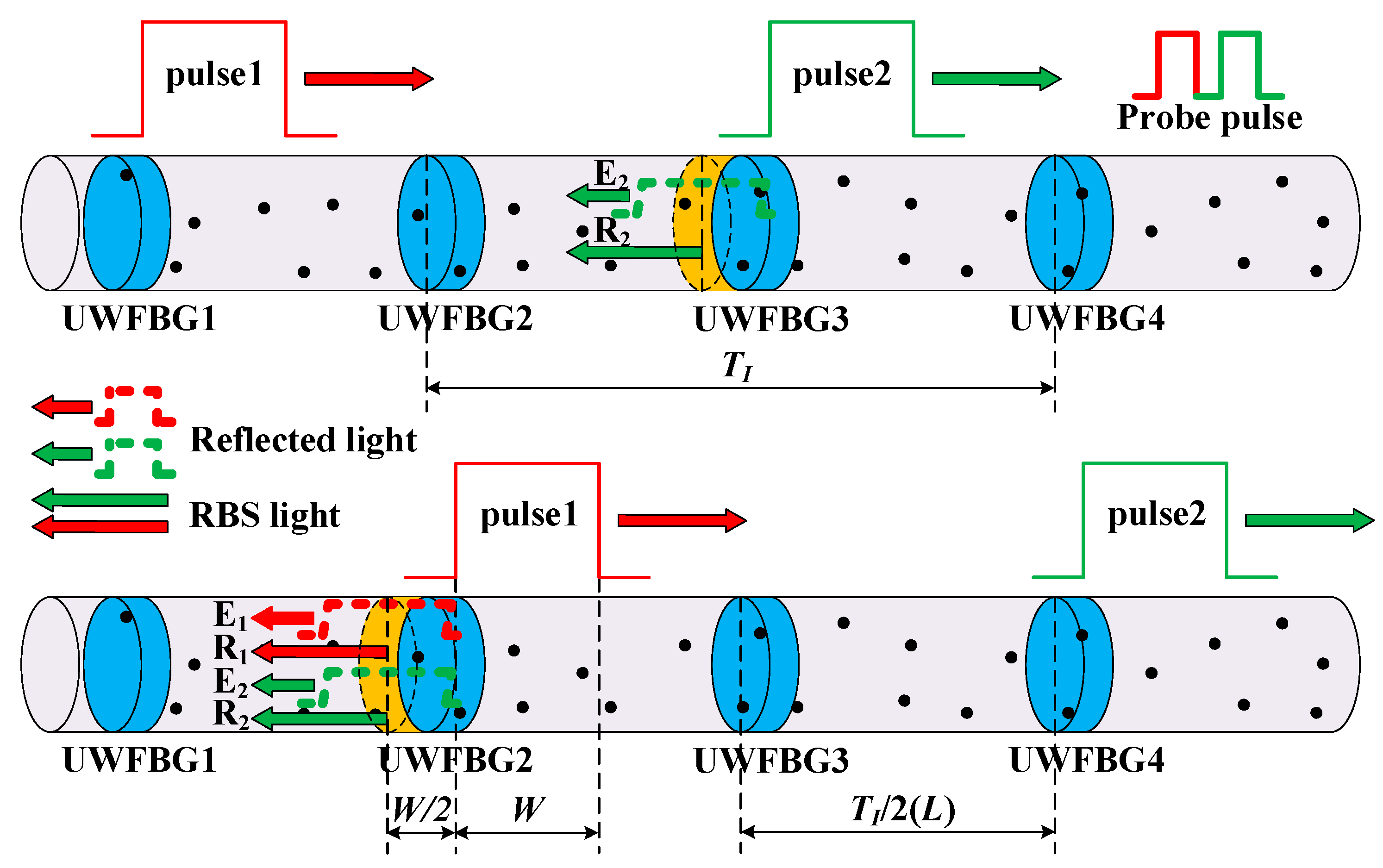
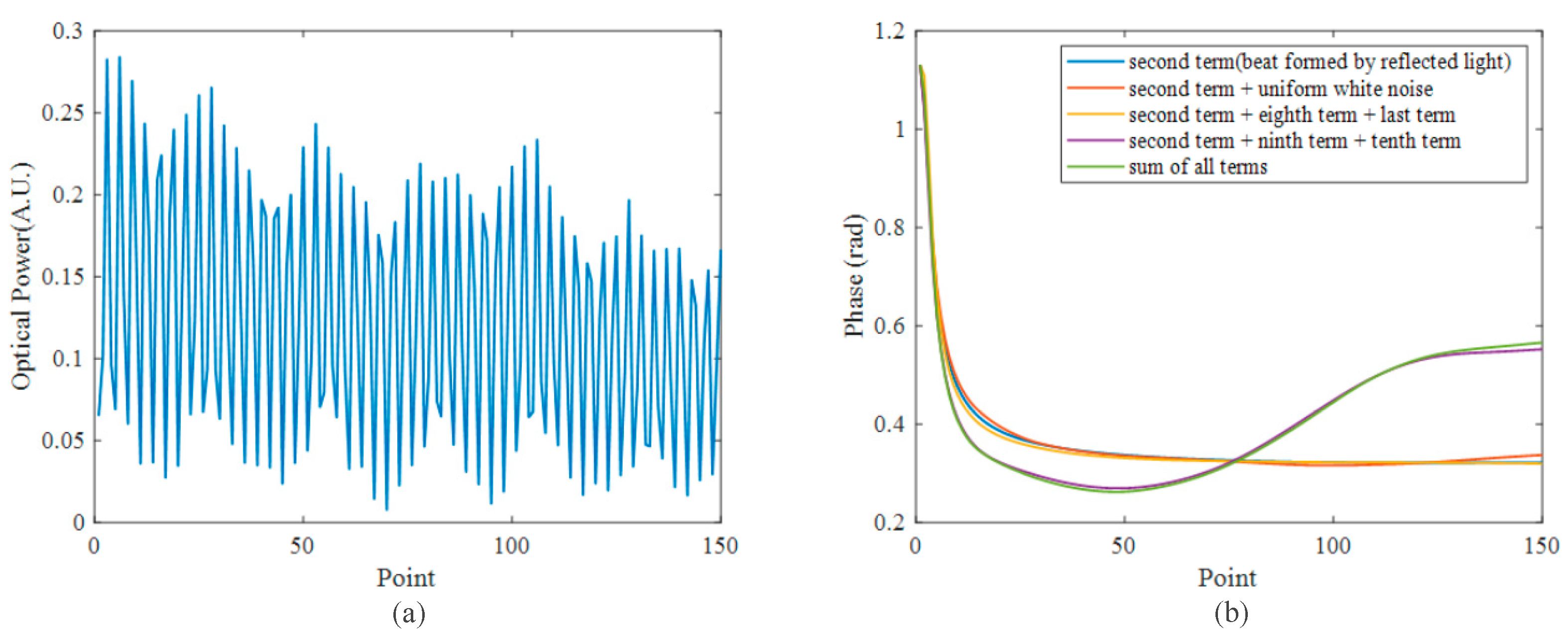
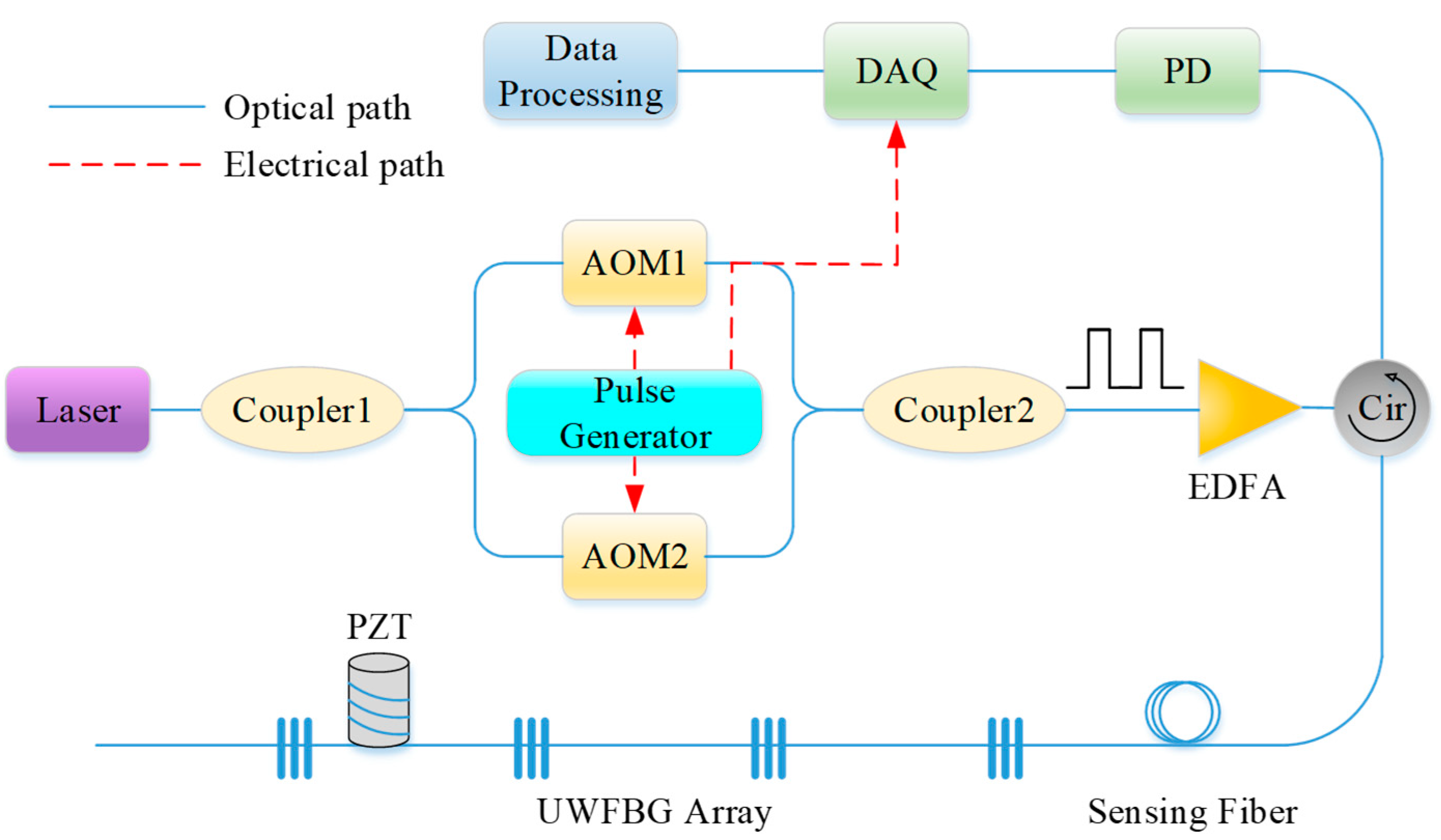

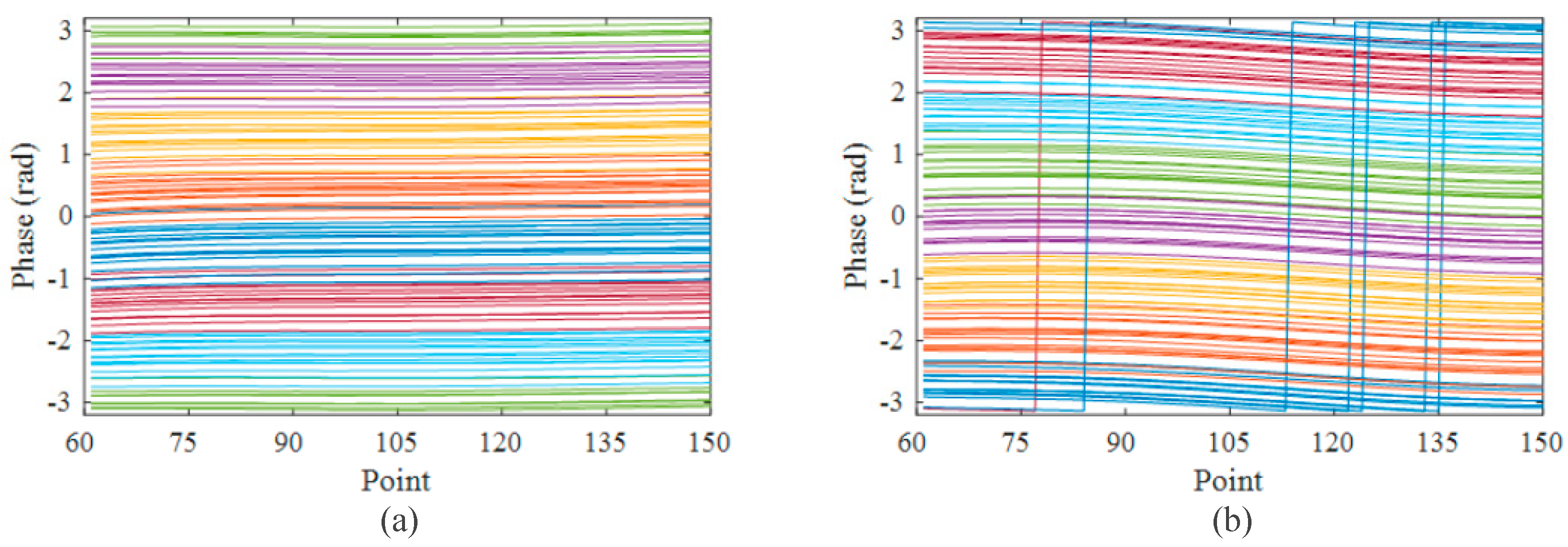
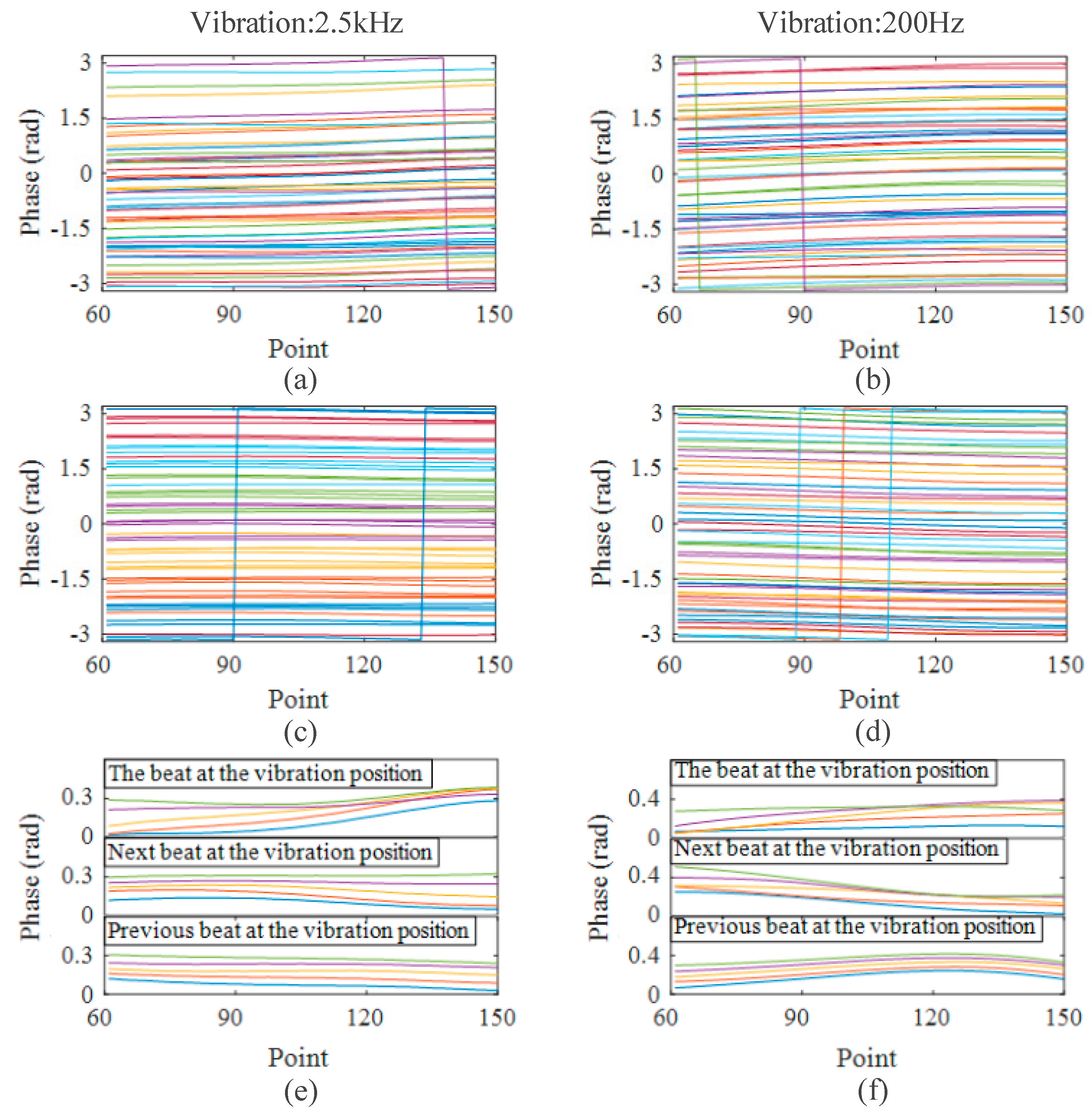
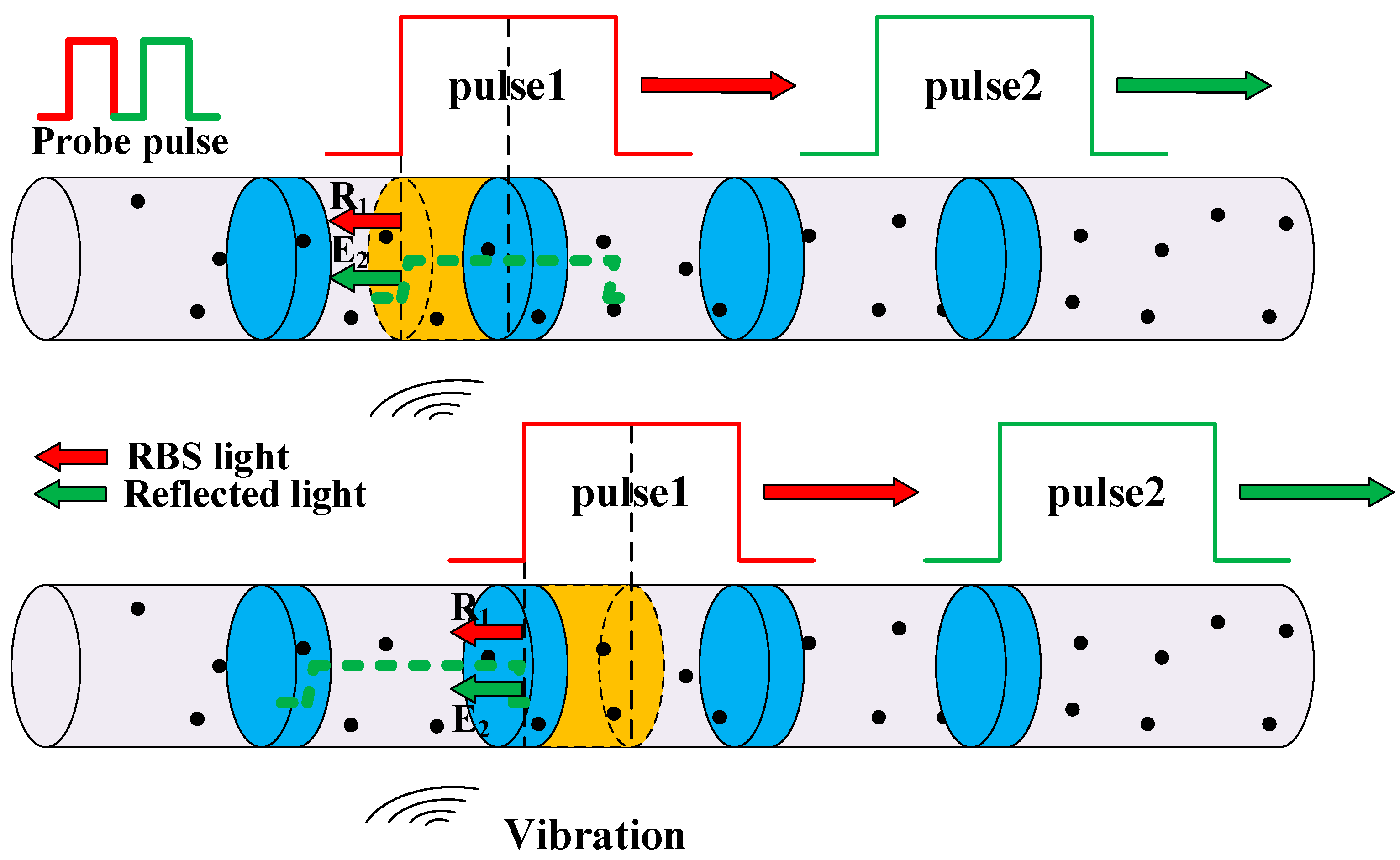
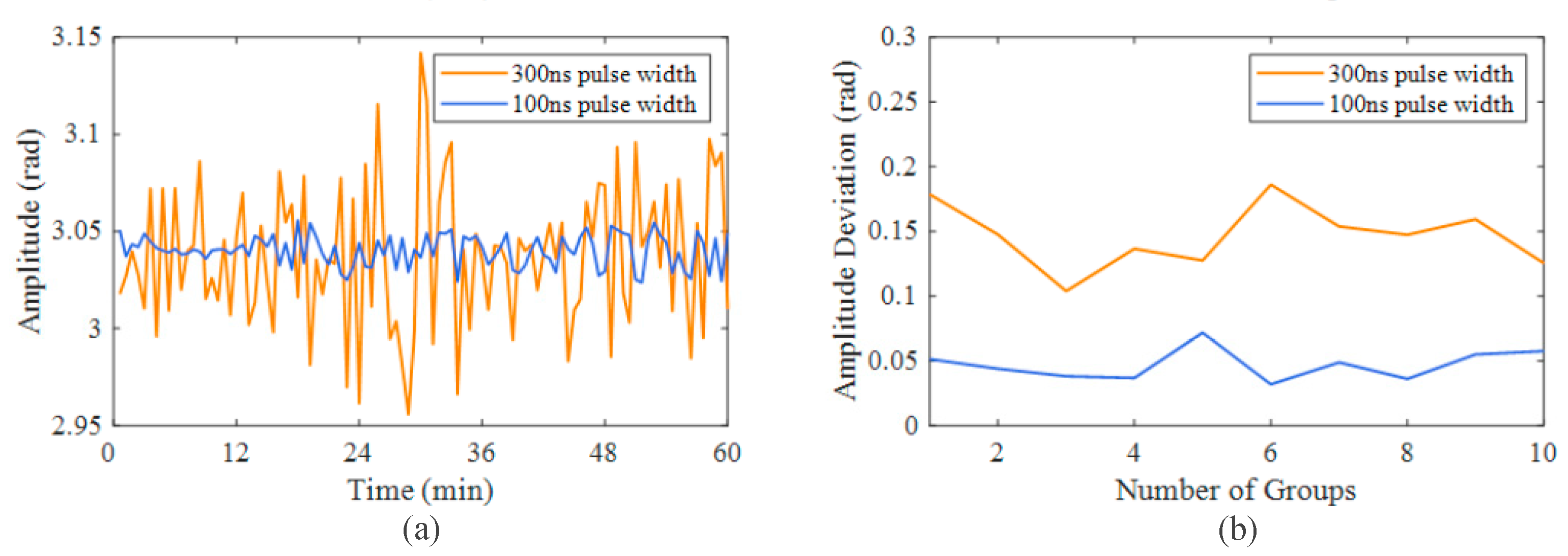
| Parameter | Value | Description |
|---|---|---|
| Optical fiber loss | 0.2 | dB/km |
| RBS coefficient | (0, 1) | Following Rayleigh distribution |
| Phase of the scattering points | (−π, π) | Following uniform distribution |
| Beat frequency | 160 | MHz |
| Sampling rate | 500 | MSa/s |
| Interval of UWFBGs | 50 | m |
| Probe pulse width | 60 | m |
Disclaimer/Publisher’s Note: The statements, opinions and data contained in all publications are solely those of the individual author(s) and contributor(s) and not of MDPI and/or the editor(s). MDPI and/or the editor(s) disclaim responsibility for any injury to people or property resulting from any ideas, methods, instructions or products referred to in the content. |
© 2023 by the authors. Licensee MDPI, Basel, Switzerland. This article is an open access article distributed under the terms and conditions of the Creative Commons Attribution (CC BY) license (https://creativecommons.org/licenses/by/4.0/).
Share and Cite
Wang, F.; Yu, Y.; Hong, R.; Tian, R.; Zhang, Y.; Zhang, X. The Impact of Rayleigh Scattering in UWFBG Array-Based Φ-OTDR and Its Suppression Method. Sensors 2023, 23, 5063. https://doi.org/10.3390/s23115063
Wang F, Yu Y, Hong R, Tian R, Zhang Y, Zhang X. The Impact of Rayleigh Scattering in UWFBG Array-Based Φ-OTDR and Its Suppression Method. Sensors. 2023; 23(11):5063. https://doi.org/10.3390/s23115063
Chicago/Turabian StyleWang, Feng, Yong Yu, Rui Hong, Ruifeng Tian, Yixin Zhang, and Xuping Zhang. 2023. "The Impact of Rayleigh Scattering in UWFBG Array-Based Φ-OTDR and Its Suppression Method" Sensors 23, no. 11: 5063. https://doi.org/10.3390/s23115063
APA StyleWang, F., Yu, Y., Hong, R., Tian, R., Zhang, Y., & Zhang, X. (2023). The Impact of Rayleigh Scattering in UWFBG Array-Based Φ-OTDR and Its Suppression Method. Sensors, 23(11), 5063. https://doi.org/10.3390/s23115063






